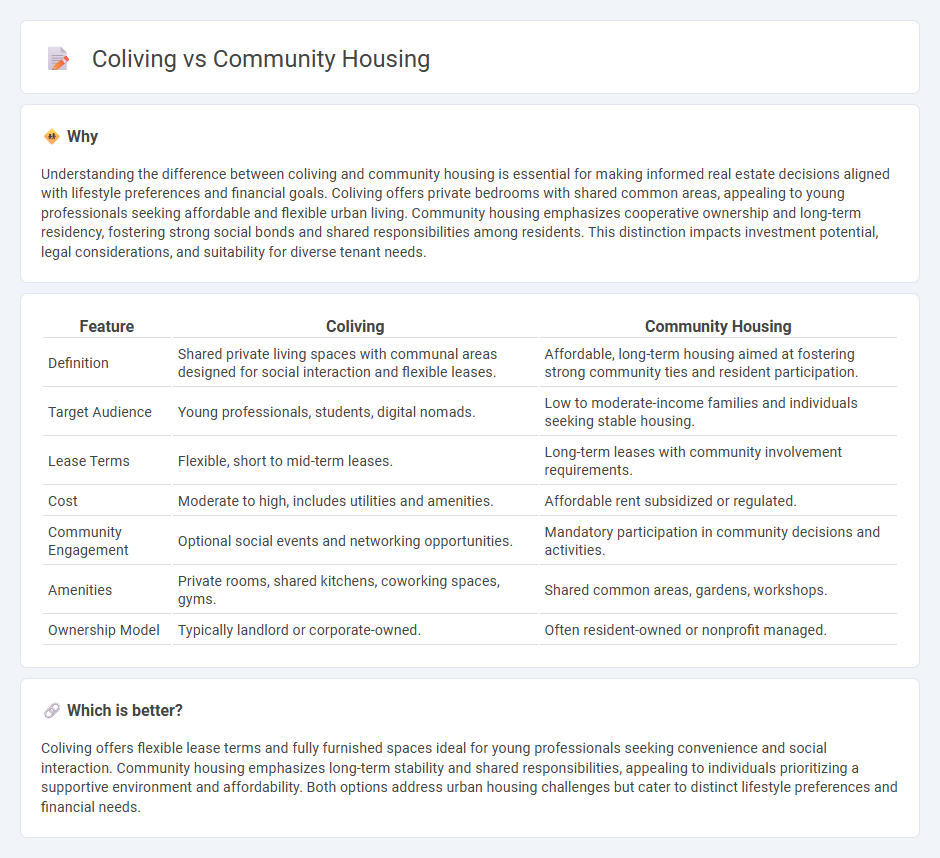
Coliving offers modern, fully furnished living spaces designed to foster social interaction among residents, often ideal for young professionals in urban areas. Community housing emphasizes shared values and collaborative decision-making, focusing on long-term social cohesion and affordability. Discover more about how these innovative housing models shape urban living experiences.
Why it is important
Understanding the difference between coliving and community housing is essential for making informed real estate decisions aligned with lifestyle preferences and financial goals. Coliving offers private bedrooms with shared common areas, appealing to young professionals seeking affordable and flexible urban living. Community housing emphasizes cooperative ownership and long-term residency, fostering strong social bonds and shared responsibilities among residents. This distinction impacts investment potential, legal considerations, and suitability for diverse tenant needs.
Comparison Table
| Feature | Coliving | Community Housing |
|---|---|---|
| Definition | Shared private living spaces with communal areas designed for social interaction and flexible leases. | Affordable, long-term housing aimed at fostering strong community ties and resident participation. |
| Target Audience | Young professionals, students, digital nomads. | Low to moderate-income families and individuals seeking stable housing. |
| Lease Terms | Flexible, short to mid-term leases. | Long-term leases with community involvement requirements. |
| Cost | Moderate to high, includes utilities and amenities. | Affordable rent subsidized or regulated. |
| Community Engagement | Optional social events and networking opportunities. | Mandatory participation in community decisions and activities. |
| Amenities | Private rooms, shared kitchens, coworking spaces, gyms. | Shared common areas, gardens, workshops. |
| Ownership Model | Typically landlord or corporate-owned. | Often resident-owned or nonprofit managed. |
Which is better?
Coliving offers flexible lease terms and fully furnished spaces ideal for young professionals seeking convenience and social interaction. Community housing emphasizes long-term stability and shared responsibilities, appealing to individuals prioritizing a supportive environment and affordability. Both options address urban housing challenges but cater to distinct lifestyle preferences and financial needs.
Connection
Coliving and community housing share a focus on fostering social interaction and affordability by creating shared living spaces that encourage collaboration and support among residents. Both models optimize urban living by maximizing space utilization and reducing individual housing costs through communal amenities and resources. The rise of these housing formats addresses the growing demand for flexible, inclusive, and sustainable living options in densely populated areas.
Key Terms
Affordability
Community housing offers long-term affordability through shared resources and cooperative ownership models, lowering individual living costs substantially. Coliving spaces provide flexible, all-inclusive rental options with utilities, amenities, and social activities bundled into a single fee, catering to urban professionals and students. Explore detailed comparisons to understand which model best fits your budget and lifestyle needs.
Shared Amenities
Community housing emphasizes shared amenities that foster long-term neighborhood engagement and support, often including communal kitchens, gardens, and recreational spaces tailored to diverse resident needs. Coliving spaces prioritize streamlined, fully furnished shared areas like lounges, coworking stations, and high-speed internet hubs designed for flexibility and convenience among urban professionals. Explore further how shared amenities shape lifestyle choices in community housing and coliving environments.
Tenure Structure
Community housing typically involves long-term leasehold or ownership models where residents have secured tenure, fostering stability and investment in the neighborhood. Coliving arrangements often operate under flexible, short-term rental agreements that prioritize adaptability and communal lifestyle over permanence. Explore the nuances of tenure structures in both models to understand their impact on housing security and community dynamics.
Source and External Links
Community Housing Network - A nonprofit organization focused on helping Metro Detroiters build thriving communities by overcoming homelessness and providing affordable housing solutions.
Community Housing Innovations - Provides housing and human services to support social and economic independence in Westchester, Long Island, Hudson Valley, and New York City.
HUD's Public Housing Program - Offers decent and safe rental housing for low-income families, the elderly, and persons with disabilities through local housing agencies.
 dowidth.com
dowidth.com